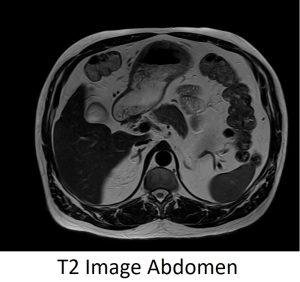Magnetic Resonance Imaging (MRI) plays a critical role in diagnosing, characterizing, and monitoring various pathologies. When it comes to chest thymoma, a specific pathology with significant clinical implications, the differentiation between T1 VS T2 MRI image sequences becomes crucial. In this article, we will explore the significance of T1 vs. T2 MRI imaging in assessing chest thymoma and highlight the utility of each sequence.
1. Anatomical Detailing with T1-Weighted Imaging
T1-weighted images primarily provide detailed anatomical information about the scanned region. In the case of chest thymoma, T1 images offer precise details regarding the tumor’s size, margins, and its relationship with adjacent structures[^1^]. This helps clinicians understand the tumor’s exact position and potential invasion into nearby tissues.
2. Tumor Characterization with T2-Weighted Imaging
T2-weighted images are essential for tissue characterization. Thymomas, being heterogeneous, can exhibit varying intensities in T2 images, aiding in their differentiation from other mediastinal tumors or cysts. Additionally, T2 sequences may indicate necrotic or cystic components within the thymoma[^2^].
3. Detection of Fat Components
T1-weighted MRI sequences are sensitive to fat. Some thymomas, particularly those with lipid-rich content, appear hyperintense on T1-weighted images. Recognizing this pattern is important as it distinguishes thymomas from other pathologies and provides insights into the tumor’s histological subtype[^3^].
4. Evaluating Tumor Invasion
Thymomas can potentially invade surrounding structures such as the chest wall, phrenic nerves, and great vessels. T2-weighted imaging, with its high contrast resolution, plays a crucial role in evaluating the extent of such invasive behavior, which informs subsequent therapeutic approaches[^4^].
5. Post-Treatment Monitoring
After therapeutic interventions like surgery or chemotherapy, both T1 and T2 MRI sequences offer substantial data on tumor response, recurrence, or potential complications. Monitoring treatment outcomes becomes vital in ensuring the patient’s health and guiding future therapeutic choices[^5^].
Conclusion
Both T1 and T2 MRI sequences provide significant diagnostic value in assessing chest thymoma. Their combined use offers a comprehensive view of the tumor, providing critical information for diagnosis, treatment planning, and post-treatment monitoring. As imaging technology continues to evolve, the precision and utility of MRI in thymoma assessment are expected to further enhance, underscoring the importance of understanding and leveraging both T1 and T2 sequences.
[^1^]: Sakai S, et al. (2001). Thymic lesions: differentiation of thymic carcinoma from noninvasive thymoma, lymphoma, and mediastinal germ cell tumor at MR imaging. Radiology, 221(1), 191-196. [^2^]: Tomiyama N, et al. (2001). Invasive and noninvasive thymoma: distinctive CT features. Journal of Computer Assisted Tomography, 25(3), 388-393. [^3^]: Inaoka T, et al. (2007). Thymic hyperplasia and thymus gland tumors: differentiation with chemical shift MR imaging. Radiology, 243(3), 869-876. [^4^]: Aquino SL, et al. (1999). Diagnosis of anterior mediastinal masses with computed tomography: pitfalls and pearls. Chest, 116(1), 17-22. [^5^]: Marom EM, et al. (2001). Computed tomography findings of thymic carcinoma. Journal of Computer Assisted Tomography, 25(6), 905-910. :::





